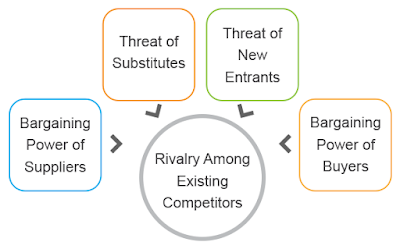Continuing our topic on tools for strategic business planning from our previous article, today we further our discussion on the topic and discuss performing competitive analysis using Porter’s Five Forces framework.
To perform competitive analysis for your business, you would need to evaluate the market, and study the competition. A good start would be to explore market reports related to your industry. These are things like market size, key players, industry trends, etc., which can provide you with valuable insights. Understanding the different aspects of your industry and knowing your competitors is crucial to the success of your business. One particular model that is very useful in this area is by Michael E. Porter. It can provide you with a holistic view of where you stand relative to your competition and the industry in general.
Porter’s Five Forces
Porter’s Five Forces framework, by Michael E. Porter, defines five main forces to consider before getting into a new market or industry.
They are:
- Rivalry among existing competitors
- Bargaining power of buyers
- Bargaining power of suppliers
- Threat of substitutes
- Threat of new entrants
Knowing your competitors
So, when doing competitive analysis, you need to consider competition, that is a given. But what constitutes competition? One obvious type of competitors is direct competitors, businesses selling the same type of products/services you are offering. Evaluating current direct competition, i.e., rivalry among existing competitors is a key starting point to find out about market status. With high competition, you can expect price wars, which means lower profit margins. So, if the competition is too fierce, you may have to take a loss for some time until you can establish a market share and people get to know your brand and the quality of your products. Market entry in a highly competitive market takes time and resources and you need to have the required financial resources to withstand these conditions. Otherwise, your business won’t make it.
Threat of substitutes
There are other types of competitors, however. Even if a company does not offer the same product you are offering, you can still compete with them over the same customer. More preciously, over their money. If your business sells soda drinks for example, your direct competitors will be those companies selling soda drinks. But what about companies selling canned fruit juice, or bottled water. A thirsty customer may choose one of these two over your soda products, making it a substitute. Hence, the threat of substitutes.
Threat of new entrants
Another type of threat is the threat of new entrants. You should not only consider current market competition, but any potential competition that may enter the market later. They may, for example, have strong competitive advantage over your business such as having a stronger capital. This would be the case if a large enterprise decides to get into your industry, making them a very strong contender. New entrants may also have you at a disadvantage if they do not have to invest as much as you did since they learned from your initial mistakes and experience and came to compete with you while not having the burden of the initial expenditure that you had. This would make it easier for them to lower their prices, making it harder for you to compete.
 |
| Porter's Five Forces |
Bargaining powers
The last two factors to consider in Porter’s Five Forces, are the bargaining power of buyers, your customers, and the bargaining power of your suppliers.
If your customers do not need to have your product and/or have many other comparable options available to them, their bargaining power would be higher. This means that you would need to provide them with more than what they are getting from your competitors if you want to acquire and keep them. You may have to lower your prices and run promotions to get them to buy your products. On the other hand, if your customers have a low bargaining power, due to a unique product that you have for example, your customers won’t be able to force you to lower your prices. In addition, you would have a steady supply and your market would be more predictable and therefore easier to plan and target.
Bargaining power also applies to your vendors, if your vendors have a big market demand for their products, your bargaining power with them would be relatively low. This means that you cannot rely on having the same prices or product quality you are currently getting. In such cases, having multiple suppliers would be the way to go. Legal contracts with details of pricing and product specifications are another way to lower your risk in this regard
Wrapping up…
These were the five factors your need to consider when using Porter’s Five Forces analysis to evaluate the competitive space of your business. Knowing the status of your industry and the market you are pursuing is vital to your market positioning, product qualities, pricing, and all the proper planning and actions you need to take to go after a market share.
In our next article of Key Business Concepts 101, we will further the discussion on competitive analysis before we move on to the next article on another key tool for business planning, management, and performance evaluation.


No comments:
Post a Comment